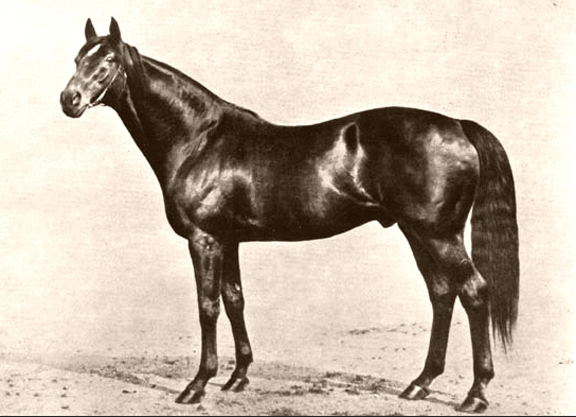By Ross Birkett
A Classic flop produced from a moderate mare who was herself out of a dam that never won-hardly the recipe for a legacy which now accounts for over 90% of the Thoroughbred population, is it? But this is Phalaris (GB) we are talking about, the most influential stallion of the last century and perhaps also the most unheralded.
Born in Newmarket on May 16, 1913, the plain bay with a white star came into the world with little fanfare. Indeed, Lord Derby's son of Polymelus (GB) and the speedily-bred Bromus (GB) ran his first two races without a name but he would come to leave a dynasty which dominates modern-day bloodlines around the world.
Sent by his owner-breeder to trainer George Lambton as a 2-year-old, Phalaris was beaten on his debut but soon made amends by winning his next two starts before being put away for the winter with a Classics campaign in mind. That plan was soon shelved after he was a well-beaten third in the Craven S. in the spring of 1916, after which he was dropped in class to handicap company and duly won three consecutive races at Newmarket with ease.
It wasn't until his 4-year old season that Phalaris was seen at his best. Now campaigned as a sprinter, he won seven of his nine races that year which culminated with wins in the Snailwell S. and the Challenge S. over five and six furlongs respectively, leading to him being crowned champion sprinter.
His 5-year old campaign was a similar story with some remarkable weight-carrying performances to his credit: he won the Lanwades Plate carrying a pound over 10 stone, with the bottom-weighted horses shouldering almost three stone less that day.
By the time of his retirement later that season, Phalaris was widely considered a great weight carrier, if not a record-breaking speedster. He was unfortunate to be around at the same time, and indeed in the same yard, as the legendary sprinter Diadem (GB), who was the apple of trainer George Lambton's eye. Lord Derby was even open to offers in excess of 5,000 guineas (£150,000 today) for the colt but none came, so he decided to stand him at Cheveley Park Stud in Newmarket for 200 guineas. The seemingly steep fee was little deterrent for breeders as he soon had a full book, though 'full' in those days was rather different to today's norm: Phalaris's first crop numbered 16 foals.
The breeders' instincts were proven correct, however, as his offspring were well received at the sales, so much so that the stallion's fee was upped to 300 guineas and he was transferred to Lord Derby's Side Hill Stud before his runners hit the track.
Some horses click in the breeding world and Phalaris did just that. He was the leading sire of 2-year olds from 1925 to 1927 and was overall champion sire in England twice, in 1925 and 1928. Later he was thrice champion broodmare sire, all three titles coming posthumously.
Manna (GB), winner of the Derby and 2000 Guineas, tops the list of Phalaris's runners. A number of his best offspring were out of mares by another of Lord Derby's stallions, Chaucer (GB), a son of St Simon (GB), and these include his influential stallion sons Pharos (GB) and Sickle (GB). The latter went on to be champion sire in America in 1934 and 1938 and is the great grandsire of Native Dancer.
Despite Lord Derby's initial hesitance to stand the champion sprinter, the key to Phalaris's success appears to be that he injected some much-needed pace into Lord Derby's stoutly-bred (albeit classy) mares at a time when popularity in the racing world was starting to shift from staying races to shorter events. Speed was a sought-after commodity and Phalaris had plenty of it.
By the time he died, while covering a mare at the age of 16 in 1931, Phalaris's legacy was secured thanks to his “compact but back at the knee” son born in 1920. That colt was the aforementioned Pharos, who went on to sire Nearco (ITY), the sire of Nearctic (Can), who sired Northern Dancer (Can). Now you can understand the old boy's influence.
At the time of his death, Phalaris was described as a moderately successful stallion, but even his biggest fan could not have predicted the lasting impact he would have on the Thoroughbred breed. Through the sirelines of Northern Dancer, Mr Prospector and Sunday Silence, the Classic flop out of a mare who won just one race is now responsible for winners all across the globe.
What set him apart? There have been stallions who have produced faster racehorses but none have been able to pass on that ability with such longevity through the generations quite like Phalaris.
Not a subscriber? Click here to sign up for the daily PDF or alerts.






